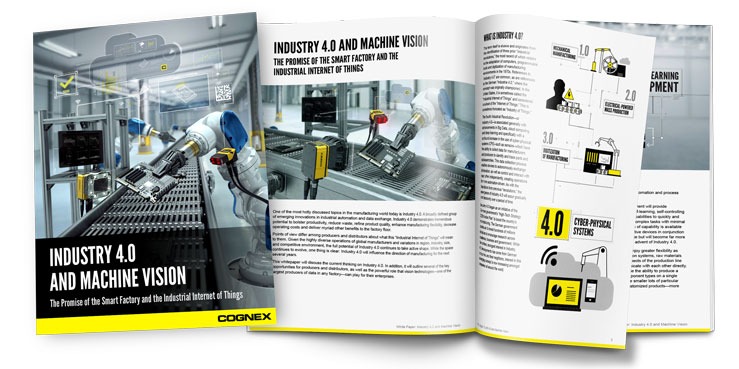One of the most hotly discussed topics in the manufacturing world today is Industry 4.0. A broadly defined group of emerging innovations in industrial automation, IoT devices, deep learning, and data exchange, Industry 4.0 is set to deliver a myriad of benefits to the factory floor. Points of view differ about what this ‘Industrial Internet of Things’ will mean to individual companies, but it is suggested that Industry 4.0 has the potential to bolster productivity, reduce waste, refine product quality, enhance manufacturing flexibility and decrease operating costs.
Given the highly diverse operations of global manufacturers, the full potential of Industry 4.0 continues to take active shape. While the space continues to evolve, one thing that is clear is machine vision technology will be an essential element to the smart manufacturing technology of tomorrow.
Unlike simple sensors, vision sensors generate large amounts of image data, intensifying their utility in an Industry 4.0 environment. No other aspect of the production line captures more information or is more valuable in assessing products and finding defects, as well as in collecting data to direct the operation and optimize the productivity of robots and other equipment.
Deep learning image analysis takes advantage of machine vision image data to teach a system how to recognize potential defects in a manufactured product. Instead of having to program a defect detection application to account for the numerous potential defects, it’s possible to find defect anomalies from a set of images marked as good products.
As data analytics capabilities progress, the high volumes of data accessible through IoT devices and vision equipment will be used in smart factories to identify and flag defective products, understand their deficiencies and enable fast and effective interventions.
Deep learning is a subset of artificial intelligence and a part of the broader family of machine learning. Instead of humans programming task-specific computer applications, deep learning takes unstructured data and trains itself to make more accurate outputs based on that training data. Deep learning applications learn and solve for narrow tasks without being explicitly programmed to do so.
Deep learning applications thrive in being able to consistently, and at scale, recognize anomalies and variance amongst a set of data. It’s something humans do intrinsically well and until now, computer systems based on rigid programming weren’t good at. Humans, though, tire easily in their decision-making while computers do not.
Deep learning technology is now migrating into advanced manufacturing practices for quality inspection and other judgment-based uses such as defect detection or final assembly verification. Much of deep learning is based on the work of neural networks. When a neural network is being trained, training data is fed to the bottom layer, the input layer, and it passes through succeeding computational layers, getting multiplied and added together in complex ways, until it finally arrives, radically transformed, at the output layer.
The explosion of deep learning technologies owns itself in no small part to the explosion in popularity of modern video games. According to MIT, “the complex imagery and rapid pace of today’s video games require hardware that can keep up, and the result has been the graphics processing unit (GPU), which packs thousands of relatively simple processing cores on a single chip. It didn’t take long for researchers to realize that the architecture of a GPU is remarkably like that of a neural net.” These modern, high-performance GPUs enabled the 50-layer neural networks of today, which has made deep learning applications possible. This gives manufacturing technology amazing new abilities to recognize images, distinguish trends, and make intelligent predictions and decisions.

The implementation and expansion of Industry 4.0 will create challenges and opportunities for machine vision suppliers. One supplier, Cognex, expects the application of machine vision systems to accelerate throughout the supply chain and in the operations of both new and existing vision users and has been at the forefront of Industry 4.0 advances by investing in products that deliver many of the productivity benefits associated with Industry 4.0.
A Cognex authored informative guide titled ‘Industry 4.0 and Machine vision – The Promise of the Smart Factory’ is available for download.
For more information: www.cognex.com
Tags: 3d vina, hiệu chuẩn, hiệu chuẩn thiết bị, Manufacturing to Get Educated with Deep Learning, máy đo 2d, máy đo 3d, máy đo cmm, sửa máy đo 2d, sửa máy đo 3d, sửa máy đo cmm
